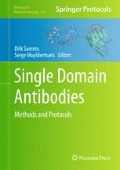Abstract
Camelidae single-domain antibodies (VHHs) represent a unique class of emerging therapeutics. Similar to other recombinant antibody fragments (e.g., Fabs, scFvs), VHHs are amenable to library screening and selection, but benefit from superior intrinsic biophysical properties such as high refolding efficiency, high solubility, no tendency for aggregation, resistance to proteases and chemical denaturants, and high expression, making them ideal agents for antibody-based drug design. Despite these favorable biophysical characteristics, further improvements to VHH stability are desirable when considering applications in adverse environments like high heat, low humidity, pH extremes, and the acidic, protease-rich gastrointestinal tract. Recently, the introduction of a disulfide bond into the hydrophobic core of camelid VHHs increased antibody thermal and conformational stability. Here, we present additional protocols for characterizing the effects of the introduced disulfide bond on a panel of llama VHHs. Specifically, we employ mass spectrometry fingerprinting analysis of VHH peptides to confirm the presence of the introduced disulfide bond, size exclusion chromatography, and surface plasmon resonance to examine the effects on aggregation state and target affinity, and circular dichroism spectroscopy and protease digestion assays to assess the effects on thermal and proteolytic stability. The disulfide bond stabilization strategy can be incorporated into antibody library design and should lead to hyperstabilized single-domain antibodies (VHHs, VHs), and possibly Fabs and scFvs, if selection pressures such as denaturants or proteases are introduced during antibody selection.
This is National Research Council Canada Publication 50015.
Access this chapter
Tax calculation will be finalised at checkout
Purchases are for personal use only
References
Sieber V, Plückthun A, Schmid FX (1998) Selecting proteins with improved stability by a phage-based method. Nat Biotechnol 16:955–960
Jespers L et al (2004) Aggregation-resistant domain antibodies selected on phage by heat denaturation. Nat Biotechnol 22:1161–1165
Arbabi-Ghahroudi M et al (2009) Aggregation-resistant VHs selected by in vitro evolution tend to have disulfide-bonded loops and acidic isoelectric points. Protein Eng Des Sel 22:59–66
Famm K et al (2008) Thermodynamically stable aggregation-resistant antibody domains through directed evolution. J Mol Biol 376:926–931
Jermutus L et al (2001) Tailoring in vitro evolution for protein affinity or stability. Proc Natl Acad Sci U S A 98:75–80
Young NM et al (1995) Thermal stabilization of a single-chain Fv antibody fragment by introduction of a disulphide bond. FEBS Lett 377:135–139
Wörn A, Plückthun A (1998) Mutual stabilization of VL and VH in single-chain antibody fragments, investigated with mutants engineered for stability. Biochemistry 37:13120–13127
Arbabi-Ghahroudi M, MacKenzie R, Tanha J (2010) Site-directed mutagenesis for improving biophysical properties of VH domains. Methods Mol Biol 634:309–330
Chao G et al (2006) Isolating and engineering human antibodies using yeast surface display. Nat Protoc 1:755–768
Harmsen MM et al (2006) Selection and optimization of proteolytically stable llama single-domain antibody fragments for oral immunotherapy. Appl Microbiol Biotechnol 72:544–551
Kubetzko S et al (2006) PEGylation and multimerization of the anti-p185HER-2 single chain Fv fragments 4D5: effects on tumor targeting. J Biol Chem 281:35186–35201
Holliger P, Hudson PJ (2005) Engineered antibody fragments and the rise of single domains. Nat Biotechnol 23:1126–1136
Arbabi-Ghahroudi M, Tanha J, MacKenzie R (2005) Prokaryotic expression of antibodies. Cancer Metastasis Rev 24:501–519
Hussack G, Tanha J (2010) Toxin-specific antibodies for the treatment of Clostridium difficile: current status and future perspectives. Toxins 2:998–1018
Hagihara Y, Mine S, Uegaki K (2007) Stabilization of an immunoglobulin fold domain by an engineered disulfide bond at the buried hydrophobic region. J Biol Chem 282:36489–36495
Saerens D et al (2008) Disulfide bond introduction for general stabilization of immunoglobulin heavy-chain variable domains. J Mol Biol 377:478–488
Chan PH et al (2008) Engineering a camelid antibody fragment that binds to the active site of human lysozyme and inhibits its conversion to amyloid fibrils. Biochemistry 47:11041–11054
Sambrook J, Fritsch EF, Maniatis T (eds) (1989) Molecular cloning: a laboratory manual. Cold Spring Harbor Laboratory, Cold Spring Harbor, NY
Greenfield NJ (2006) Using circular dichroism spectra to estimate protein secondary structure. Nat Protoc 1:2876–2890
Greenfield NJ (2006) Analysis of the kinetics of folding of proteins and peptides using circular dichroism. Nat Protoc 1:2891–2899
To R et al (2005) Isolation of monomeric human VHs by a phage selection. J Biol Chem 280:41395–41403
Author information
Authors and Affiliations
Corresponding author
Editor information
Editors and Affiliations
Rights and permissions
Copyright information
© 2012 Springer Science+Business Media, LLC
About this protocol
Cite this protocol
Hussack, G., MacKenzie, C.R., Tanha, J. (2012). Characterization of Single-Domain Antibodies with an Engineered Disulfide Bond. In: Saerens, D., Muyldermans, S. (eds) Single Domain Antibodies. Methods in Molecular Biology, vol 911. Humana Press, Totowa, NJ. https://doi.org/10.1007/978-1-61779-968-6_25
Download citation
DOI: https://doi.org/10.1007/978-1-61779-968-6_25
Published:
Publisher Name: Humana Press, Totowa, NJ
Print ISBN: 978-1-61779-967-9
Online ISBN: 978-1-61779-968-6
eBook Packages: Springer Protocols

